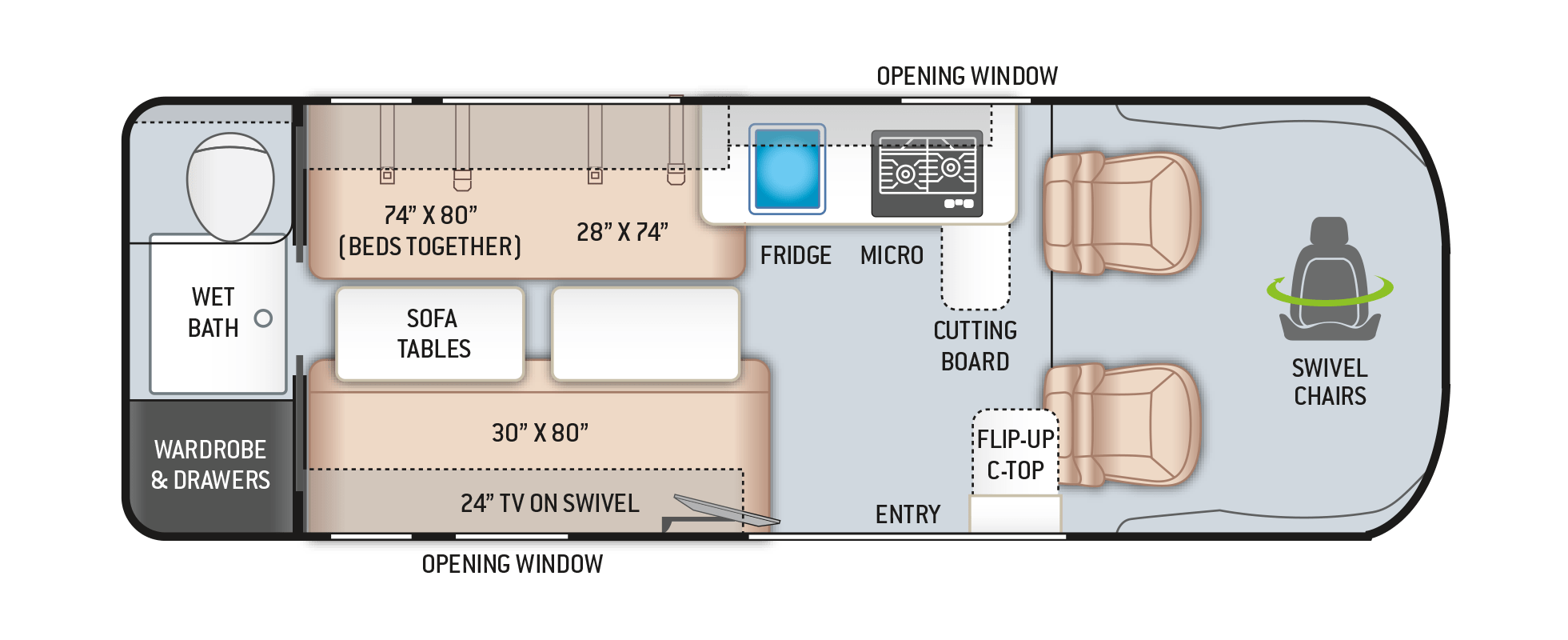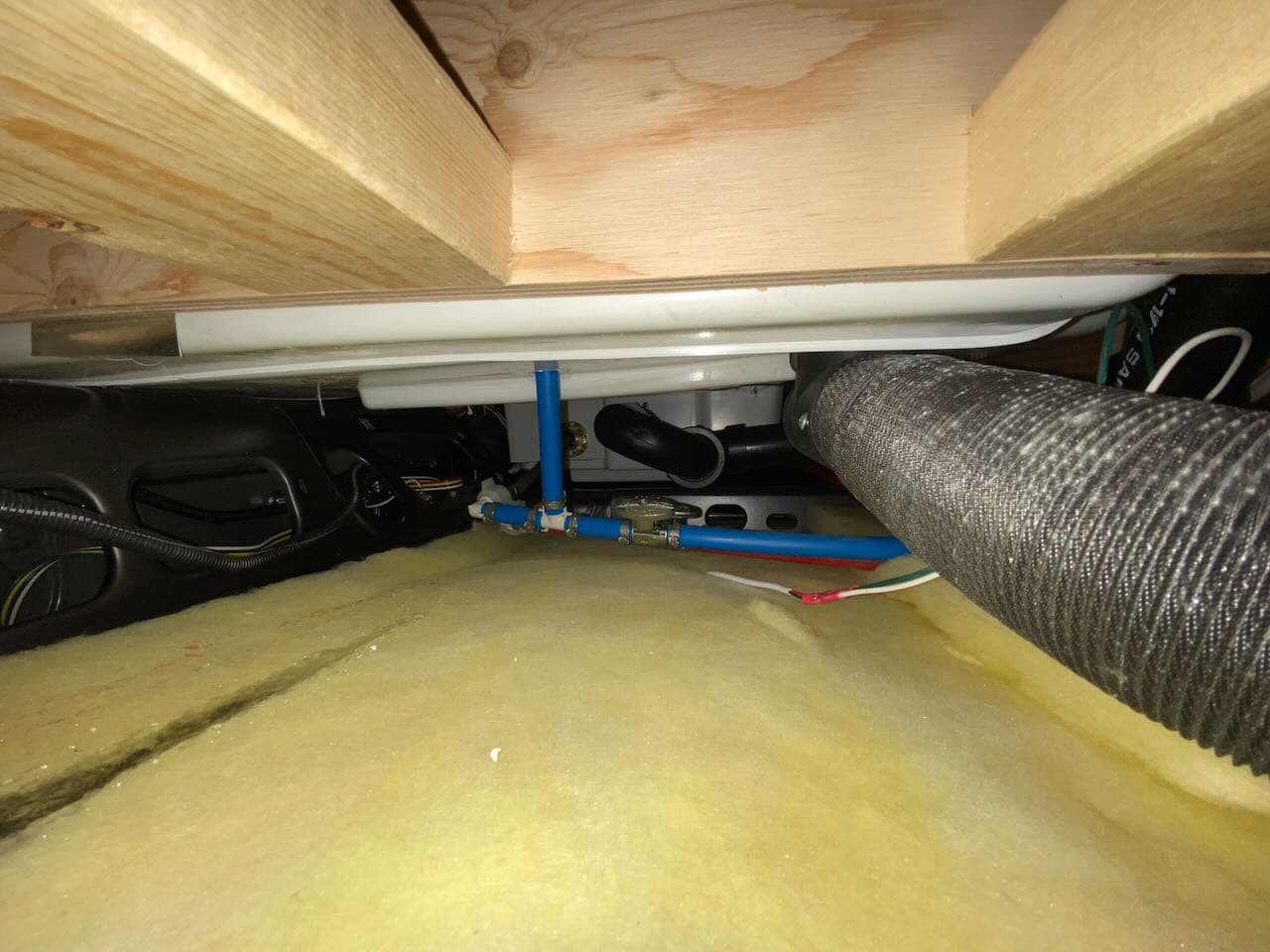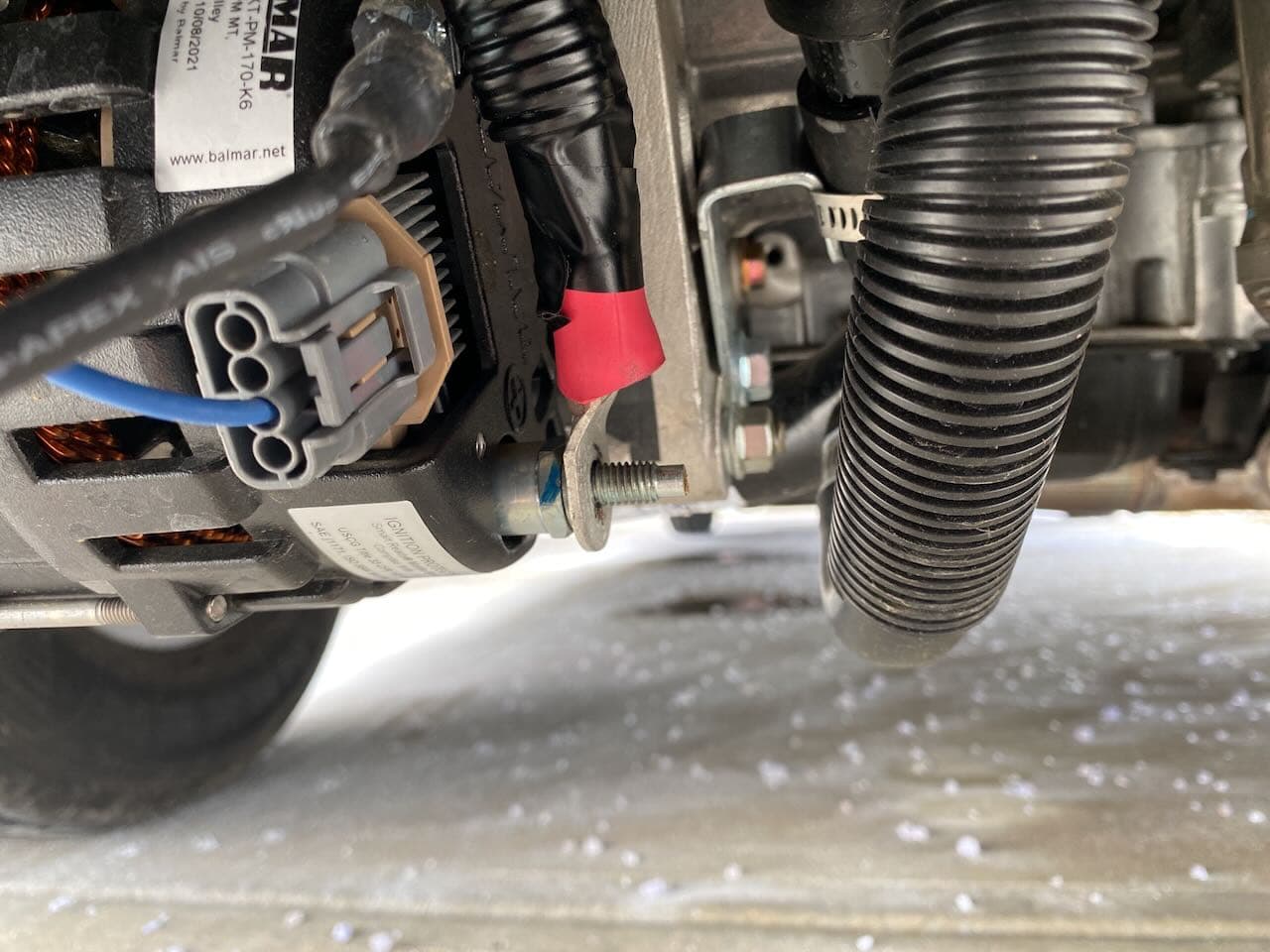
First off, some text for the search engines. The Tellaro also goes by the name Sequence, which has different cabinetry colors. This difference is because LazyDays sells the Tellaro and CampingWorld sells the Sequence. It's silly, and also I found both of them at both brands in my searching. Of note, the version of the Tellaro/Sequence I have specifically is the 2nd half of production where the AGM + Generator system was replaced with a small 200AH Lithium system.
What I like about the rig

Thor Tellaro 2022 L Floor Plan
Overall, I think the use of space is efficient. There aren't any interior walls except for the bathroom, so it feels fairly spacious and open and you have views in almost every direction. The finishings are light and comfortable, and it generally feels modern inside. The rig is fully equipped from the factory including (a rather basic) LTE Internet solution.
The Chassis/Driving Experience
"It drives pretty good for a house" pretty much sums up how it drives. The Promaster chassis is compliant, stable and easy to operate. Fuel economy is reasonable (I'm getting 16-19 depending on how I drive), and even without stabalizers it doesn't really move around while you're inside. You do sit quite high up, and need to be mindful of the size of vehichle you're driving but it's not enormous or difficult.
Upper Storage Cabinets
The upper storage cabinets provide lots of space to store things. When closed, they're attractive and out of the way. I do have a couple nitpicks on them, one being they have a curved back even though the van itself isn't curved at that location and that eats into the usability of the space. The other being the hinges – when the doors are open they sag down and are easy to conk your head into. They also don't sit consistently between cabinets, and they don't positively lock so under a hard turn objects have a tendancy to slip past the door.

Upper Cabinets open
The Kitchen
Overall I'm a fan of the kitchen. There's a reasonable sized 12V compressor fridge, a combination microwave/convection oven, sink and gas range. Everything can be operated without connecting to or starting a generator/shore power, and all the components work well. The countertops are pleasant, easy to keep clean and seem reasonably durable. The big letdown in the kitchen are the drawers - specifically the slides. I haven't quite nailed what's wrong with them but they hang and drag while also having a tendancy to fly open randomly.
The Living Area
In my typical configuration, I leave the driver's side in a couch configuration and the passenger side I use for a bed. This is a pretty flexible arrangement, and overall I like the thought behind it. The TV is easily positioned to be viewable from any of the normal living spaces, and is pre-wired for your favorite set-top-box or DVD player. I haven't used the dining tables much for just me, but I have used the "airline table" behind the passenger seat extensively. I think the space utilization is exceptionally efficient, flexible and comfortable. Unfortunately, the construction of the beds is exceptionally poor - especially when you consider there are maintenance items that require taking parts off of them. The couches are made out of 1/8" chipboard screwed together with what appear to be random screws covered in a vinyl veneer. Those fastenings are already failing on me, which is far from surprising. The driver's side headrest also came unscrewed the first time I tried to use it.
The Bathroom
It's cramped. There are no awards for prime pooping positions, award winning showers or anything else to be had here. It's functional but not luxurious. But what nobody says is, that's a good thing in a Class B! You don't spend much time in the bathroom, the more you use it the more you have to do tank duty, and the more space you dedicate to the bathroom the less you have for living space.
 Leaking water
Leaking water
I did encounter some problems in the bathroom though, the biggest being a water leak caused by a loose hot water line. Another problem is the way the sink is secured in the stowed position is very flawed - using only a small magnet that is levered out of the way by the anchor wire used to hold the sink up.
Additionally, the cabinetry suffers from similar problems as the rest of the coach. Doors that don't stay closed and drawers that have junky feeling slides.
The Systems
One of the final tipping points that led me to buy this rig over some of the alternatives had to do with the change over to a Lithium battery system. Lithium systems in motorhomes aren't new, but until now they have only been available in high-capacity (and high cost) options. In this system, instead of having ~10kWh battery bank, has a small ~2kWh battery bank but retains the same general charging infrastructure. In practical terms, that means you can run the AC for about 4 hours on battery instead of 20 hours. While solar is an often demanded and advertised feature, you need to understand what it's capable of here as well. Practically speaking the roof could support about a maximum of 400 watts of solar panels, and it ships with 190W. That means this bank could in theory recharge from solar in about 11 hours of full sun, and the larger pack would take 55 hours. You aren't running AC off of solar power, and if you're somewhere hot just park in shade and call it good. The primary methods of getting power back into these banks is to drive them or plug them into shore power or a portable generator. It takes about 90 minutes to charge while driving and charging from shore power/generator depends on how much power you aren't using for other things (like the AC). Since this does have a lithium system, it does mean that you can use a small portable generator instead of needing something that can power all of your surge loads because the inverter can actually boost the incoming power on those occasions. I enjoyed using this feature to run the AC and Microwave at the same time on my recent trip to Florida, something you normally can't do in a 30 Amp RV.
Unfortunately, the integration of this system was exceedingly poor. I spent hours crawling under the rig and chasing wires, reading manuals for the various components and ultimately buying hundreds of dollars worth of additional equipment to fix the issues. I'm not convinced I'm out of the woods yet either, as the Lithium batteries are mounted unprotected from the cold outside and have proven to be prone to disconnecting in cold temperatures leaving the entire unit inoperative. I could, and probably will, write a whole series about what was wrong with that system and how it could've been improved but the worst offender is that the second alternator was not fully installed.
 Alternator missing nut
Alternator missing nut
The main current-carrying cable from the alternator was not properly secured, and the alternator controller was not programmed for the battery type. Either one of those mistakes could've permanently damaged or destroyed not only the alternator but other components of the system as well. After correctly programming the alternator and inverter/charger, things do generally seem to be working well. The solar charge controller has some behavior that is problematic, but it's also a basic unit that doesn't perform well so that might be an upgrade opportunity down the road.
With everything configured correctly, the system is excellent. In mild climates where a dehumidifier or ventallation yield a comfortable space there's almost nothing to think about or do to maintain plenty of power. Using the microwave to warm up lunch parked on a beach and taking a conference call in a parking lot with the AC cranked all were awesome experiences that really made my trip a lot more pleasant - all without a generator. Day trips to go adventuring meant leaving the AC in the coach on, and returning from a hike to a comfortable space with a cold beverage ready to go. For extended stationary energy my plan is to either use campground provided shore power or a small portable generator. There isn't currently a viable off-grid solution for such a small rig.
My overall opinion
Overall I'm happy with the rig. I think Thor really made some mistakes when it comes to cost optimization and the design and integration of the electrical system, but just as they would be easy fixes for Thor to implement they're asy for an end consumer to implement (except for the electrical system integration). I'll slowly add reinforcement to the furnishings and change out slides and hinges for more appropriate options as I have time to research them. I also don't think Thor's service center was well trained on how to answer or route questions related to the new electrical system with replies taking days and being generally inaccurate. I was never put in touch with someone who could actually answer my questions as to the intentions behind the design and nobody was able to understand my feedback that I spoke to. It's pretty clear to me that if you buy this rig with this electrical system you are very much on your own for making it work properly and it was never designed or tested for use in below-freezing temperatures. Keep in mind, the battery system must be functioning even if plugged into shore power for the furnace to work.
Tips and Suggestions to Owners
Always carry a small space heater. The furnace isn't the "Plus" sku so it only runs on propane, and as I said before it only works when the battery system is working - which is isn't designed to do in below freezing temperatures. That also means your grey/black tank heaters won't work, so plan accordingly there too like keeping RV Anti-Freeze with you to dump down the tanks if you get a surprise extended freeze.
Update the software on the RV Master control panel. The new version has a "dark mode" skin that's much more attractive. It also gains some easy UI for managing the Wineguard antenna.
Google TV has a data saver mode, and the Shield TV is surprisingly energy efficient while having AI Upscaling to bring back some of the detail lost to the lower bitrates. This is a pretty great pairing for the included TV if you don't decide to use a tablet or other solution.
The included USB ports are a shared 2.1A between the ports. It's a pretty easy swap to put in standard 12V outlets and then you can use whatever charger is appropriate for the thing you want to charge. Be mindful of the total available power on those circuits though.
There's a switch on the inverter/charger to enable the inverter functionality. You might need to turn that on if when shore power is disconnected your mastervolt panel goes black. You can access it by removing the headrest on the driver's side bed.
Closing Remarks
Reach out if you have any questions! I'm happy enough with the rig, but really wish Thor had gone the extra mile to put in better hardware, quality control and integration. That would've been a great spend of around $1,000 in the area of customer satisfaction and ensuring they don't send someone out with soemething genuinely dangerous. I also think they should've put the batteries inside rather than re-using the AGM mounting plates and hardware because without heated batteries this is a recipie for problems. There's plenty of room for the batteries without even giving up storage or re-desigining cabinetry. There are also a lot of unsecure cables and modules that really seem like an unnecessary risk when a few dollars worth of cable ties would secure them just fine.